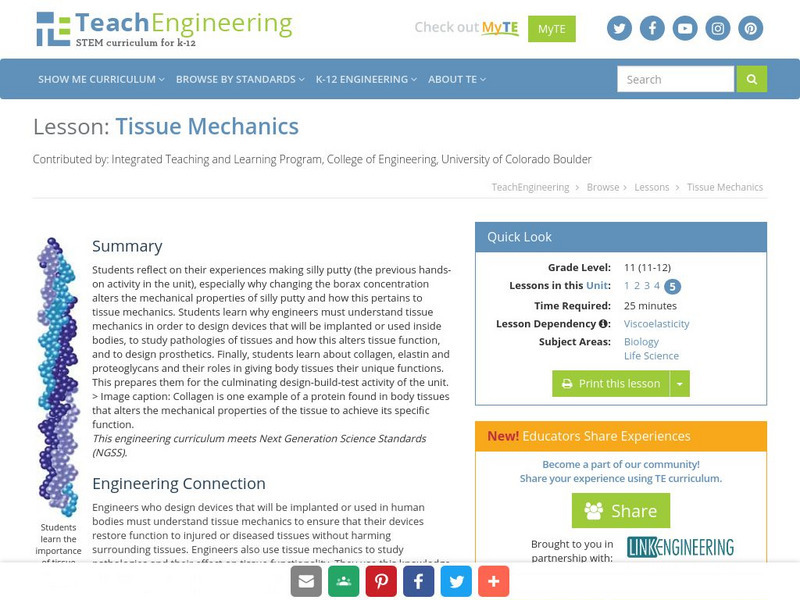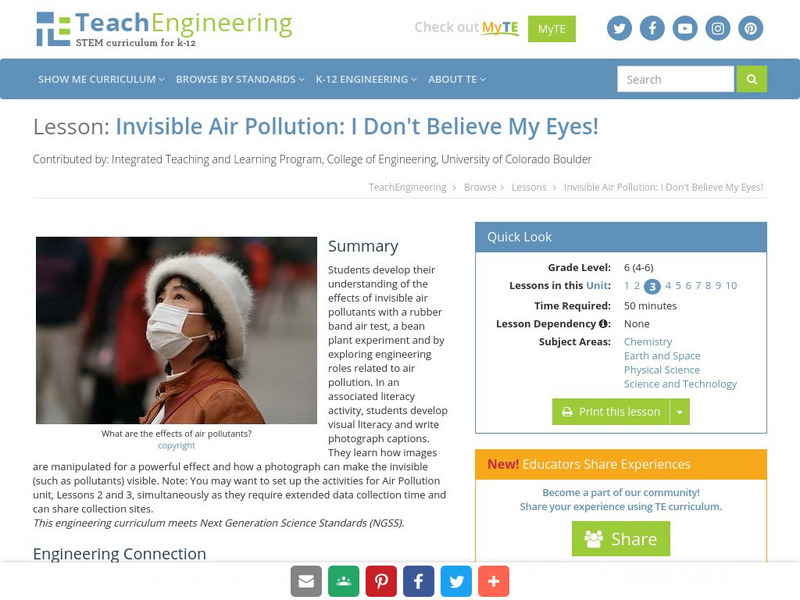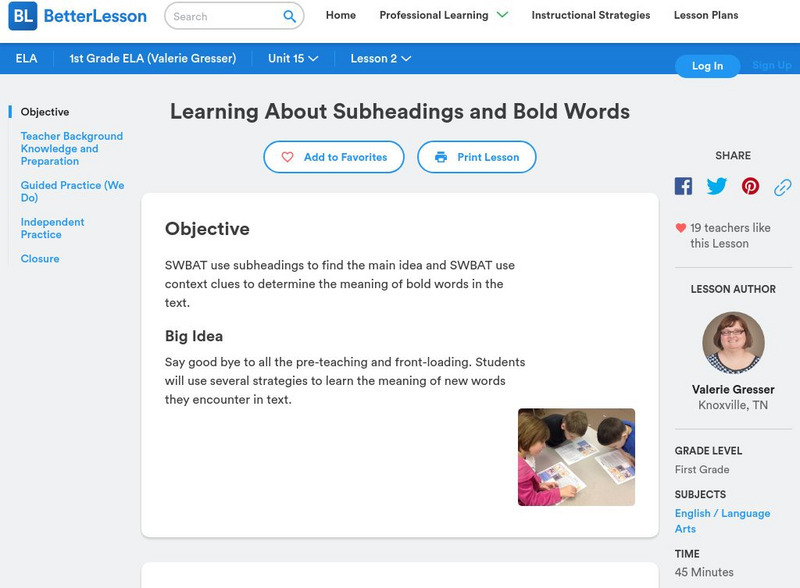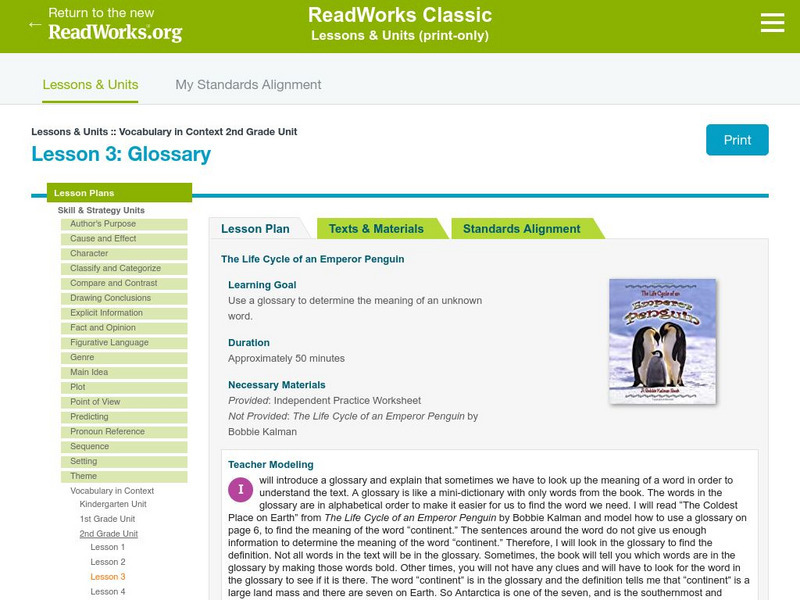Hi, what do you want to do?
Curated OER
Bermuda: Search for Deep Water Caves 2009: Out of Darkness
Students analyze the three models on the origin of troglobitic fauna. In this life science lesson, students also consider how the Zonation model explains the fauna's origin. They also use the Internet to research solutional and volcanic...
Curated OER
Using Pictures to Read the Past
Young scholars use primary and secondary sources, using the Internet and other media.
Curated OER
Images As Persuasion
Students examine how images can persuade or influence an audience. They discover how the message an image sends depends on the perspective of the audience.
Curated OER
Photos from the Past
Students observe and interpret historic photographs of water in New Mexico. They record observations, draw inferences, and compare water in New Mexico's past with water today. They create a class book or exhibition of the photographs...
Curated OER
Sowing Seeds of Service
Third graders use metric measuring for model and actual plan in designing a roof garden. They photograph the process, record results in a journal, and plant seedlings in small containers. Finally, 3rd graders complete an acid rain...
TeachEngineering
Teach Engineering: Tears in Rain
The goal of this activity is for students to develop visual literacy. They learn how images are manipulated for a powerful effect and how a photograph can make the invisible (pollutants that form acid rain) visible (through the damage...
TeachEngineering
Teach Engineering: Tissue Mechanics
Students reflect on their experiences making silly putty (the previous hands-on activity in the unit), especially why changing the borax concentration alters the mechanical properties of silly putty and how this pertains to tissue...
ReadWriteThink
Read Write Think: Using Science Texts to Teach the Organization of Nonfiction
Contains plans for three lessons that use science textbooks to teach about the organizational features of nonfiction such as labels, captions, headings, and fonts. In addition to objectives and standards, this instructional plan contains...
TeachEngineering
Teach Engineering: I Don't Believe My Eyes!
Students develop their understanding of the effects of invisible air pollutants with a rubber band air test, a bean plant experiment and by exploring engineering roles related to air pollution. In an associated literacy activity,...
Better Lesson
Better Lesson: Learning About Subheadings and Bold Words
In this lesson, students will use several strategies to learn the meaning of new words they encounter in text. The students will learn specific strategies so when they encounter new words, they can figure out the meaning of those words...
Teachnology
Teachnology: Lesson Plan: Write Me a Picture
In this lesson, 3rd through 5th graders select related pictures from magazines and newspapers, write captions for each, glue them in sequence on a poster board, and use the pictures to tell a story.
Read Works
Read Works: Vocabulary in Context 2nd Grade Unit: Glossary
[Free Registration/Login Required] A lesson in which students learn to use a glossary to determine the meanings of unfamiliar words. Lesson utilizes the book The Life Cycle of an Emperor Penguin by Robin Johnson and Bobbie Kalman and...
Scholastic
Scholastic: Teaching With Nonfiction: Teach Text Features
A brief lesson plan, this site offers an example of non-fiction text and a graphic organizer to help orient students to the features they need to use when reading for information.
Better Lesson
Better Lesson: Where Did You Learn That?
As adults, we explore pictures, captions, diagrams and text, when reading any kind of informational piece. Kids can do this too! In this lesson, students will sort information that was obtained from pictures and diagrams, from that...
Curated OER
Photo of Woman in a Reference Room With the Caption \Census 2000
The Census Bureau has grouped a number of helpful resources here, including reference information on the bureau and its history, free teaching materials, and news about Bureau programs to assist in education. ESL and Adult Literacy Kit...
New Zealand Ministry of Education
Nz Ministry of Education: Extra! Extra!
In this lesson plan students will learn about newspapers including the parts of a newspaper, purpose, and structure of articles. They will gather, record and present information from a variety of sources, using different technologies and...
PBS
Pbs Learning Media: Greenland Mass Variation Since 2002
Scientists study ice sheets because they influence weather and climate, playing a role in atmospheric and ocean circulation. Ice sheets can also have huge impacts on global sea levels because they store so much water. Explore this...
PBS
Pbs Learning Media: What Is Albedo?
When light strikes an object it can cause reflection or absorption depending on the wavelength of the light and the property of the material that makes up the object. Watch this whiteboard animation for a full explanation and to find out...



















